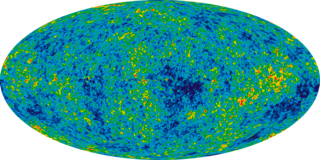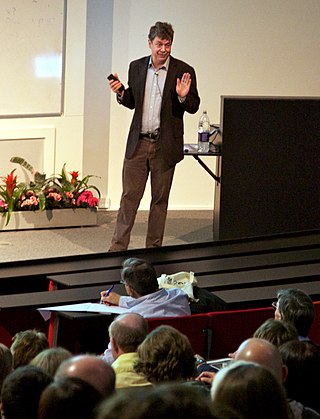
Physical cosmology is a branch of cosmology concerned with the study of cosmological models. A cosmological model, or simply cosmology, provides a description of the largest-scale structures and dynamics of the universe and allows study of fundamental questions about its origin, structure, evolution, and ultimate fate. Cosmology as a science originated with the Copernican principle, which implies that celestial bodies obey identical physical laws to those on Earth, and Newtonian mechanics, which first allowed those physical laws to be understood.

In astronomy, dark matter is a hypothetical form of matter that does not interact with light or other electromagnetic radiation. Dark matter is implied by gravitational effects which cannot be explained by general relativity unless more matter is present than can be observed. Such effects occur in the context of formation and evolution of galaxies, gravitational lensing, the observable universe's current structure, mass position in galactic collisions, the motion of galaxies within galaxy clusters, and cosmic microwave background anisotropies.

A supercluster is a large group of smaller galaxy clusters or galaxy groups; they are among the largest known structures in the universe. The Milky Way is part of the Local Group galaxy group, which in turn is part of the Virgo Supercluster, which is part of the Laniakea Supercluster, which is part of the Pisces–Cetus Supercluster Complex. The large size and low density of superclusters means that they, unlike clusters, expand with the Hubble expansion. The number of superclusters in the observable universe is estimated to be 10 million.

Harlow Shapley was an American scientist, head of the Harvard College Observatory (1921–1952), and political activist during the latter New Deal and Fair Deal.

Jan Hendrik Oort was a Dutch astronomer who made significant contributions to the understanding of the Milky Way and who was a pioneer in the field of radio astronomy. The New York Times called him "one of the century's foremost explorers of the universe"; the European Space Agency website describes him as "one of the greatest astronomers of the 20th century" and states that he "revolutionised astronomy through his ground-breaking discoveries." In 1955, Oort's name appeared in Life magazine's list of the 100 most famous living people. He has been described as "putting the Netherlands in the forefront of postwar astronomy".

Vera Florence Cooper Rubin was an American astronomer who pioneered work on galaxy rotation rates. She uncovered the discrepancy between the predicted and observed angular motion of galaxies by studying galactic rotation curves. By identifying the galaxy rotation problem, her work provided evidence for the existence of dark matter. These results were later confirmed over subsequent decades. The Vera C. Rubin Observatory in Chile is named in her honor.

Fritz Zwicky was a Swiss astronomer. He worked most of his life at the California Institute of Technology in the United States of America, where he made many important contributions in theoretical and observational astronomy. In 1933, Zwicky was the first to use the virial theorem to postulate the existence of unseen dark matter, describing it as "dunkle Materie".
Jeremiah Paul "Jerry" Ostriker is an American astrophysicist and a professor of astronomy at Columbia University and is the Charles A. Young Professor Emeritus at Princeton, where he also continues as a senior research scholar. Ostriker has also served as a university administrator as Provost of Princeton University.

Phillip James Edwin Peebles is a Canadian-American astrophysicist, astronomer, and theoretical cosmologist who was Albert Einstein Professor in Science, emeritus, at Princeton University. He is widely regarded as one of the world's leading theoretical cosmologists in the period since 1970, with major theoretical contributions to primordial nucleosynthesis, dark matter, the cosmic microwave background, and structure formation.

The Coma Cluster is a large cluster of galaxies that contains over 1,000 identified galaxies. Along with the Leo Cluster, it is one of the two major clusters comprising the Coma Supercluster. It is located in and takes its name from the constellation Coma Berenices.
Density contrast is a parameter used in galaxy formation to indicate where there are local enhancements in matter density.
The Gruber Prize in Cosmology, established in 2000, is one of three prestigious international awards worth US$500,000 awarded by the Gruber Foundation, a non-profit organization based at Yale University in New Haven, Connecticut.

Knowledge of the location of Earth has been shaped by 400 years of telescopic observations, and has expanded radically since the start of the 20th century. Initially, Earth was believed to be the center of the Universe, which consisted only of those planets visible with the naked eye and an outlying sphere of fixed stars. After the acceptance of the heliocentric model in the 17th century, observations by William Herschel and others showed that the Sun lay within a vast, disc-shaped galaxy of stars. By the 20th century, observations of spiral nebulae revealed that the Milky Way galaxy was one of billions in an expanding universe, grouped into clusters and superclusters. By the end of the 20th century, the overall structure of the visible universe was becoming clearer, with superclusters forming into a vast web of filaments and voids. Superclusters, filaments and voids are the largest coherent structures in the Universe that we can observe. At still larger scales the Universe becomes homogeneous, meaning that all its parts have on average the same density, composition and structure.

Simon David Manton White, FRS, is a British-German astrophysicist. He was one of directors at the Max Planck Institute for Astrophysics before his retirement in late 2019.

In cosmology, galaxy filaments are the largest known structures in the universe, consisting of walls of galactic superclusters. These massive, thread-like formations can commonly reach 50/h to 80/h megaparsecs —with the largest found to date being the Hercules-Corona Borealis Great Wall at around 3 gigaparsecs (9.8 Gly) in length—and form the boundaries between voids. Due to the accelerating expansion of the universe, the individual clusters of gravitationally bound galaxies that make up galaxy filaments are moving away from each other at an accelerated rate; in the far future they will dissolve.

The cornerstone of the Estonian cosmological research is the Tartu Observatory which was founded in 1812. The observatory itself has a long tradition of studying galaxies and theoretically modeling the structure of the universe and its formation. Till today this facility is Estonia's main research centre for astronomy and atmospheric physics, with fundamental research focusing on physics of galaxies, stellar physics and remote sensing of the Earth's atmosphere and ground surface. The observatory has also played a vital role in catapulting the career of Jaan Einasto, one of the most famous and eminent Estonian astrophysicists and one of the discoverers of "Dark Matter" and of the cellular structure of the Universe.

The Hercules Superclusters refers to a set of two nearby superclusters of galaxies.

Cosmic voids are vast spaces between filaments, which contain very few or no galaxies. In spite of their size, most galaxies are not located in voids. This is because most galaxies are gravitationally bound together, creating huge cosmic structures known as galaxy filaments. The cosmological evolution of the void regions differs drastically from the evolution of the Universe as a whole: there is a long stage when the curvature term dominates, which prevents the formation of galaxy clusters and massive galaxies. Hence, although even the emptiest regions of voids contain more than ~15% of the average matter density of the Universe, the voids look almost empty to an observer.















